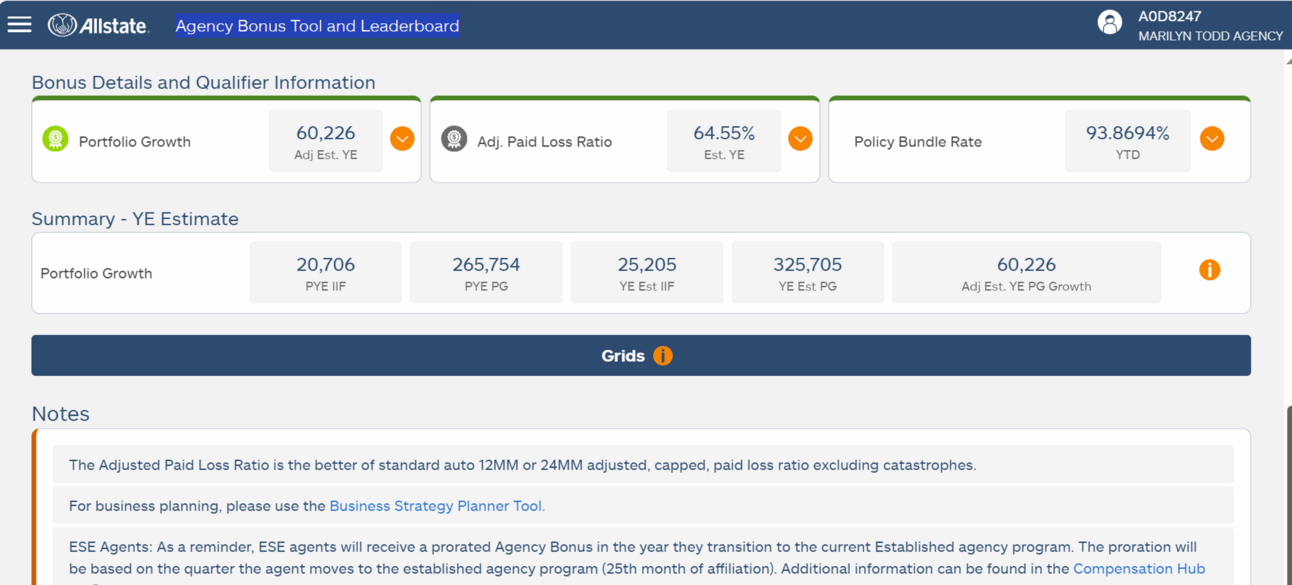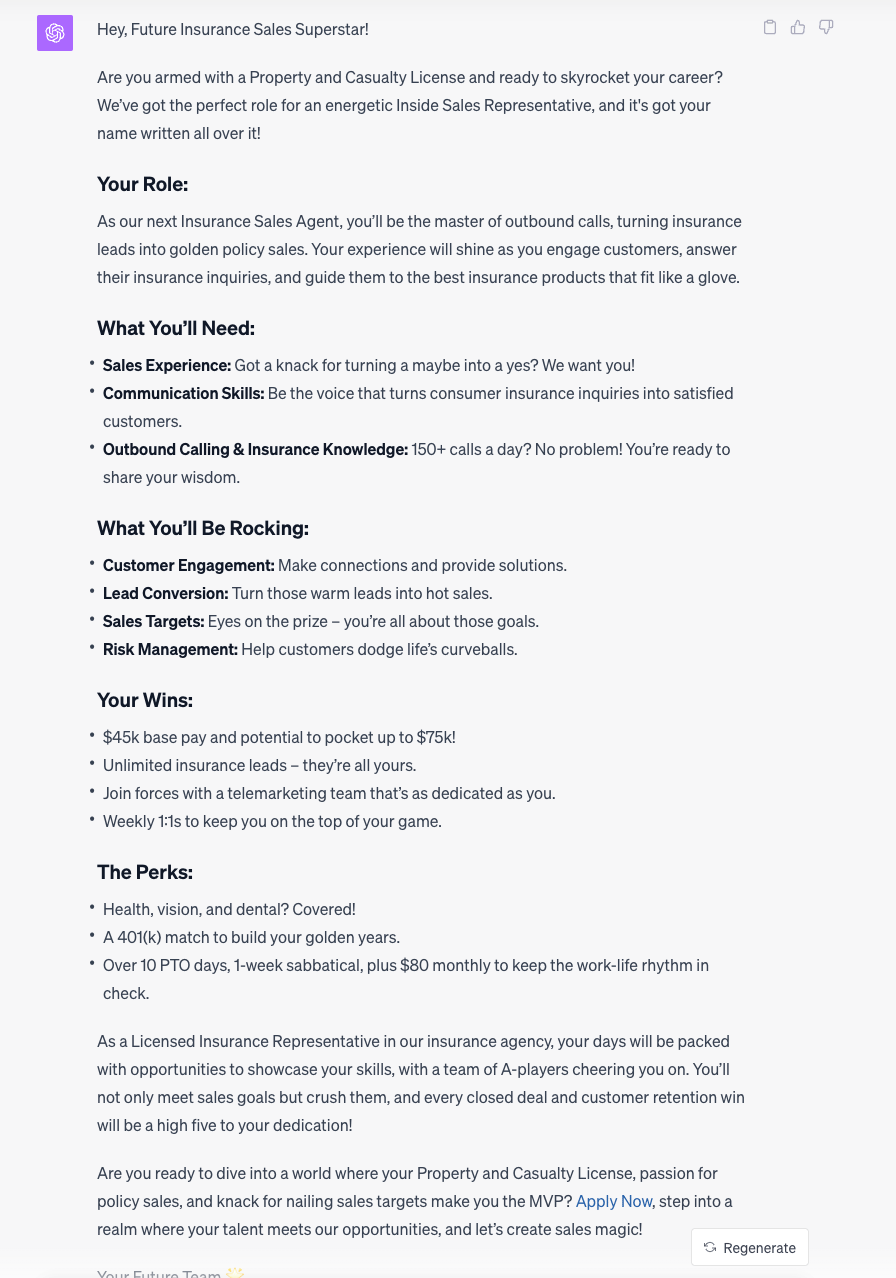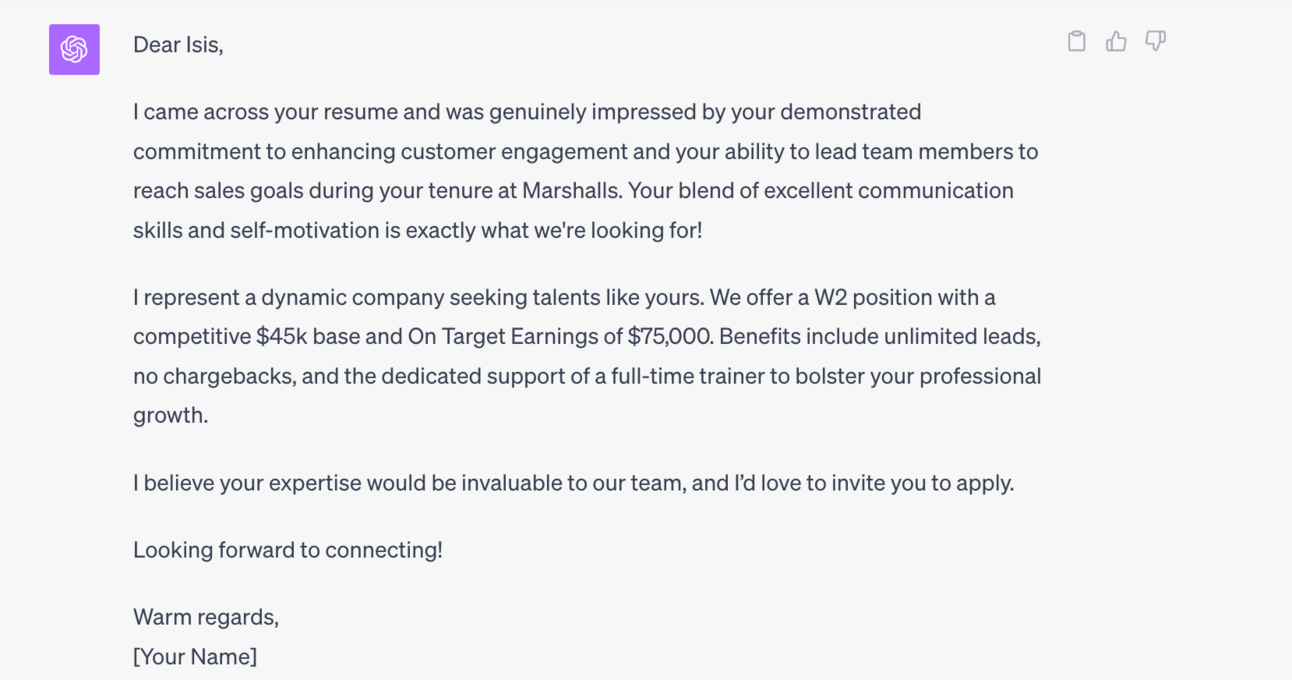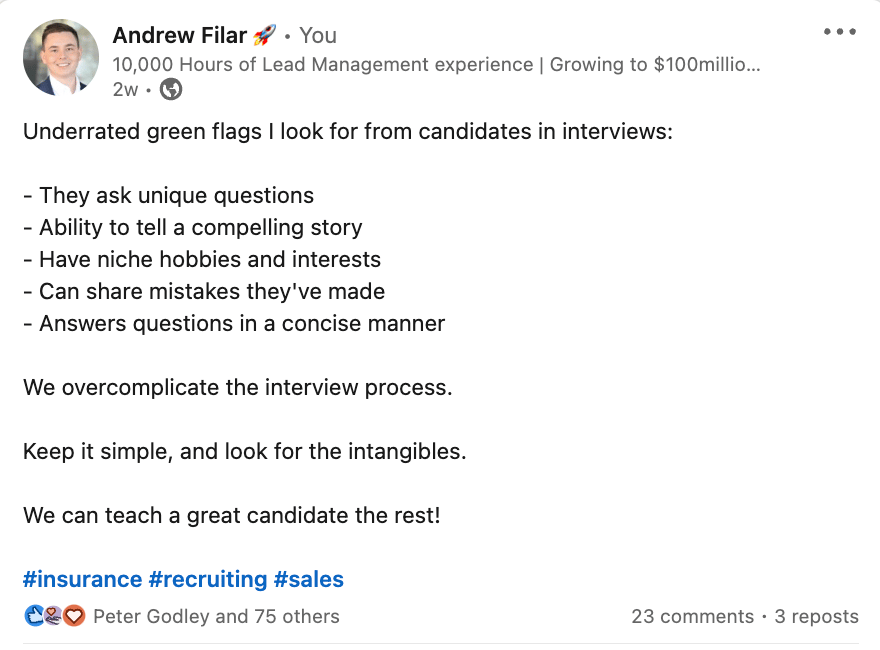
The All Aboard Newsletter
Today’s newsletter will be a short one. I’ve been traveling quite a bit and haven’t had as much dedicated time to this week’s issue. We’ll be back with a full issue on November 3rd.
Today we’ll touch slightly on growth and our Q4 strategy, then I’ll show a few ChatGPT prompts to help with hiring and recruiting.
As a favor, if you get value out of this newsletter, please consider sharing it. Whether its an agent, an office manager, or someone in the industry, I’d very much appreciate it.
Lets take a ride!
Growth Update!

17 LSPS + 1 Monoline Specialist
In September, we grew by $502,065!
That growth number falls pretty much in range with what we’ve been seeing the last few months, and sets our pace to be just shy of $40million in premium at our 6 year mark.
In September, our production and premium per item dipped quite a bit.
October is seeing a slight bounce but we’re going to need to wait and see what happens when the latest 18% auto rate hits (10/23).
Something to remember when forecasting growth from rate increases: We never fully capture the rate.
As of September, our Auto Book is around $22,000,000 in premium.
We expect to capture about 12% of the total 18% rate.
That assumes that we’re going to see roughly a 6% drop in auto retention (From 81.65% to 75.65%).

When your retention tanks
But…. there’s a silver lining!
If we can capture 12% of the rate, that means our auto book will grow by roughly $2.5million on rates alone.
Not too bad a consolation prize I suppose.
The hard part will always be bridging the cashflow gap between the immediate cancellations/terminations and the full rate cycle when the rate fully bakes in.
In the last 60 days we’ll have taken:
12.5% Home Rate
18% Auto Rate
Tightened Home RMPs (Age/Losses)
Tightened Auto RMPs (IS Score/Operators)
And while these are hurdles are going to make hitting our sales goals harder, they’re also going to ensure our sales team levels up.
Smooth seas don’t make good sailors.
And soft markets don’t make great producers.
As a result of these changes, we need to re-examine our strategy and figure out the right move for the next few months.
Since the RMP changes, our marketing spend is up 30% and our production down nearly 30%.
That’s not sustainable. We need to get profitable, at least for a few months.
That doesn’t mean we’re going to fire people, or stop spending.
We’re simply going to stop hiring salespeople for a couple months. That means focusing on our current people and ensuring they’re polished up and in fighting shape.
As people leave or fail to hit goals, we won’t backfill them.
In August we had 20 LSPs selling and 4 people in training.
Today we have 18 LSPs and 3 people in training.
Our close ratios are down, both for newbies and veterans alike. When that happens, bringing new people in isn’t ideal.
The best time for someone to learn how to sell in the agency is during a good or at least neutral rate environment.
They can win some sales on price, get some traction, and start hitting goals.
But in a tough rate environment, where even your veterans are struggling, how likely is it a new person is going to be successful?
Probably not very.
So while we may not all have the luxury of tightening the hatches down, its something to consider if your rate environment isn’t ideal.
I like to think of it like this:
- Good rate environments = People sell on price and value
- Tough rate environments = People only sell on value
The latter is harder, and its in my opinion when a producer earns their stripes.
But its just unrealistic to expect a high success rate (at least in our system) when dealing with such strong headwinds.
We’re not going to fight the current, and we’ll work on polishing up our team until other companies start taking rates.
Then we’ll go back on the attack.
That being said, a lot of the efforts in Q4 for us will be focused on generating revenue in two new areas.
Commercial
Life Insurance
As I’ve spoken about in previous issues, both of these verticals will be an important part of our strategy in 2024 and beyond.
We have a goal of getting to $100million, and doing that all in Home/Auto just isn’t realistic without a roll-up of acquisitions.
Even if we got approval to do it, we probably wouldn’t - We simply can acquire business at too low a rate to make it worth it (at least right now).
Commercial and Life represent two revenue streams we’re not currently taking advantage of, and that needs to change.
So while we work to drive the best possible production possible in q4, we’re also going to be asking people about life and business use vehicles more than ever.

Not sure about y’all, but our DASH has been really messed up.
Right now its showing our loss ratio is 64.55%
But I know its about 71%.
Dash baby, don’t tease me like that!
We’ll hope that DASH isn’t lying + me and the team are bad at maths.
ChatGPT Hiring
Everyone thinks they know how to use ChatGPT.
But few are using it to its potential (including me). I’m here to give a few tips to better increase the utility of the tool.
There is an art to using ChatGPT or other Large Language Models (LLMs). Its what people call “prompt engineering.”
How we ask our questions, ultimately changes the answers it gives us.
So, if you don’t give great instructions, or put up guardrails, guess what?
You’re going to sound like everybody else who is using the tool, and thats no good.
Plus your copy/writing will have way more emoji’s to boot (ChatGPT LOVES emojis).
So here are some quick tips to using ChatGPT. Whenever you prompt:
Give it context → Whats the situation
Give it a job/role → Tell it what type of expert to be.
Give it guardrails → Want it under 500 words written in a 3rd grade level?
Give it feedback → The model learns, so build off the prompts and tweak to get it right
Ultimately, my opinion on AI is relatively positive.
I’m not a doomer who thinks AI going to replace us all. Because when people use AI today, it tends to be obvious and comes across as phony.
I’ve seen it all over social media. People who use AI to write comments, posts, epitaphs etc are getting straight up blocked by other users.
So, with that being said… Use AI, but use it as an assistant. Something that is there to enhance you, not replace you.
While I haven’t used AI to do the following tasks for my agency, I have used them to assist me and my team in getting started with a multitude of tasks.
I figured I’d share four quick use cases of how you can use ChatGPT in your agency to improve your hiring and recruiting.
1.) Identify Keywords for job ads
Why focus on keywords?
If you know anything about search, whether its on Google, Bing, Youtube, or Linkedin, you know that the more relevant keywords in your content, the more likely you are to show up.
Why should we treat our job ads any different?
We spend hours on our marketing copy, making sure it looks good. Making us easy to find.
But we spend about 5 minutes on our job ad slapping something together with no regard for how hard or easy it is for applicants to find us.
That’s where keywords come in.
The more keywords you have in your job ad, the more likely you’re going to match someone’s search.
The more you show up in search, the more people find you. The more people find you, the more people will apply.
Voila
So lets ask ChatGPT for some keywords.
The Prompt:
Act like a [copywriting expert].
I'm trying to find a person to join my [insurance agency] as a [sales person]. This role will [make outbound calls on consumers who have put their insurance information in online].
The role requires [an insurance property and casualty license]. Please give me 20 keywords to include in my job ad that I should integrate into my job description to get better visibility on searches
The Result:
Insurance Sales Agent, Property and Casualty License, Outbound Calls, Insurance Leads, Sales Experience, Customer Engagement, Lead Conversion, Insurance Products, Sales Targets, Communication Skills, Consumer Insurance Inquiries, Licensed Insurance Representative, Risk Management, Policy Sales, Customer Retention, Insurance Agency, Sales Goals, Customer Service, Insurance Knowledge, CRM Software
I’ve highlighted the variables in brackets above, and you can change them for roles, businesses, and requirements as needed.
The results on the keywords aren’t perfect, but this isn’t the endpoint, its the beginning and I can tweak from here.
For instance, I’d probably swap out “customer retention” for “cold calling” and “risk management” for “outbound sales.”
2.) Write a job description
Want to know the first thing I think of when I read most job descriptions?
“BORING”
Seriously, they’re so dry.
I don’t know if its because someone wrote them who has never done the job, or they actively want to repel applicants.
Your job ad is akin to your first impression to a candidate.
If they’re finding your open role on a job board like Indeed, Linkedin, ZipRecruiter, or any other job board we must assume they know nothing about us.
It doesn’t matter how beautiful our website is if they never see it.
It doesn’t matter how great our culture is if we never get a chance to talk with them and tell them how great it is.
It baffles me that job descriptions are so lame, both in insurance and other industries.
It just feels like something we all forget about and do the bare minimum creating.
I did the same thing for YEARS before putting some extra attention towards mine.
I wish I had done it sooner.
Nobody wants to work in insurance so badly that they’re going to find a boring, stuffy job description and say “LETS GO!!!!!”
So, how should we do it?
Well, for one we should aim to stand out. And two, we should try to write it in a way that our ideal candidate feels that the ad was written for them.
The Prompt:
Act like an [expert copywriter]. Write a job ad for an [Inside Sales Representative].
This role is for a [licensed insurance agent], where they will [make 150+ outbound calls per day]. The pay is [$45k base with an on target earnings of 75k]
Please write it as if you were writing it directly to the ideal candidate.
The ideal candidate should have the following traits: [Great Work Ethic, Coachable, Team Player, Self-Starter, Resilient, not afriad of rejection]
Please touch on the following benefits: [Health Insurance, Vision insurance, dental insurance, 401k with match, 10+ days PTO, 1 week sabbatical a year, $80 per month for work life balance reimbursement.]
What is in it for the sales rep = [Unlimited Leads to call, training and development, a team of a-players, a telemarketing team to send over live prospects, weekly 1:1s with managers]
Please include a call to action at the end to apply. Write it on a 3rd grade level and limit complex sentences.
Please include the following keywords [insert 20 keywords from last prompt]
Here, we’ve given it extensive guardrails. Specifically to write on a third grade level and to limit complex sentences.
GPT can get pretty flowery in its word choices (diction 😘)
The call to action is important. We need to tell the applicant what we want to do.
The Result:

Screenshot was just easier to do than a block quote!
While this isn’t written in my voice, it gives me a great place to start from.
This is something I would likely take as a skeleton, and build on. The format itself is something that I like, the language used just doesn’t fit me or my team.
Either way, its done the heavy lifting of:
Formatting it
Getting started
Giving/Getting inspiration
3.) Create an outbound message inviting to apply
A lot of us will reach out to people on Indeed or Linkedin if we see something on their resume or profile that intrigues us.
Sometimes we have a phone number, in which case, just call right?
But when we don’t, we’ll need to craft a message to invite them to apply to work with us. While it seems easy, its not always so.
How many emails do you get per day?
If you’re like me, its hundreds. And on mobile, where we can only see 4-5 emails at a time, things get buried.
We must stand out!
That starts with crafting a great message.
The Prompt:
Act like an [expert recruiter who is a master at cold messaging].
Look at the following resume and craft a message to the candidate inviting them to apply.
Please make sure this message is no more than 750 characters. Please reference 1-2 things that were impressive from their resume and include these benefits: [On Target Earnings $75,000, W2 with $45k base, full-time, unlimited leads, no chargebacks, full-time trainer.]
Resume = [paste resume text here]
The Result:

This result is actually pretty good.
Its short, to the point, and personalized. Even though the personalization is minimal, its clear that its not a templated message that is sent 100s of people.
The reality is that most people don’t even bother to take a look at the person’s resume, profile, or socials in general.
When we take a few minutes to do that and reference it in our messages.
Applicants notice.
We stand out.
Our odds improve!
4.) Creating traits-based interview questions
I’ll admit, this is probably my least favorite of the four prompts.
Not because I think the results are bad, but rather because I like to kind of “freestyle” it in interviews.
But thats a problem.
Because if we always freestyle it, we have inconsistent questions and inconsistent answers.
It means that we largely hire by gut or by feel.
The issue with that is we all have biases, and sometimes they can get us in trouble.
I’ll give you an example: I’m a sucker for confidence.
When I interview people and they present themselves as confident, and 100% sure they’re going to succeed, I’m sold.
The problem?
Its usually all talk.
I busted my tail, and scrapped and scraped when I was getting started. So when people tell me they’re going to do the same, I see myself, and I like them.
Hiring is like a sports draft.
Its imperfect. Incredibly hard to get right.
And even if you follow the best plan, do everything 100% right, its still easy to make a mistake.
So thats why we ask the same questions every time, and we tailor those questions towards traits we’re looking for.
The goal should NOT be to “qualify” a candidate based on their answers.
The goal should be to disqualify.
Instead of going in with no boxes checked and looking to check them, go in with all boxes checked and look to uncheck them.
If its not a hell yea, its a hell no.
Maybe’s can hit the bricks.
The prompt:
Act like an interviewing expert.
Please create 5 questions to ask a person interviewing for a sales role. Please ensure the questions are concise, and the questions don't lead the candidate to a specific answer.
We want one question that helps identify each of the following traits: [1.) Assertiveness 2.) Concientiousness 3.) Team Player 4.) Work Ethic 5.) Resilience]
The results:

Do you see how starting with the end in mind before getting the question can help find what you’re looking for?
Just something to note:
Always ask someone to tell you about themselves. If they spend 10+ minutes talking without an amazing story/payoff, be afraid. If they talk too much to you, they’ll likely do the same to your customers.
One of the single biggest green flags that someone can show in an interview is being concise.
Here are a few other green flags:

I’m currently 9 full months into my daily Linkedin writing challenge!
Between the tips in the last issue, and some help from ChatGPT, I hope you have gotten a few nuggets around hiring.
Hiring is tough
I always tell my team:
“Its ok to make a bad hire. Its not ok to hold on to that bad hire too long”
Hire slow, fire fast.
But take care when doing it.
These are real people, with real lives.
How have you used AI to help in hiring/recruiting?
On my mind this week:
Double Mega Agency Conferences
I’ve been traveling for about two weeks, and I have one week to go.
For the back half of this travel stint, I’m attending/attended two different “Mega” events.
Both Farmers and Allstate have conferences where some of the biggest agents and top writers get together to share ideas, network, and grow together.
These are some of my favorite events of the year.
Not because the learnings are so great, or the vendor interactions are something to write home about.
Those things are fine (certainly not bad), but the real value comes in connecting with others who are further ahead than you.
Nobody is the best at everything.
Nobody is the smartest at everything.
I can’t tell you how many times people say “I don’t write as much as you” when talking.
Knock that off!
Just because I may write more right now, it doesn’t mean that I can’t, or don’t want to learn from you.
I consider myself an expert in lead management and outbound calling.
I am not an expert at direct mail, running 5+ businesses at once, being a parent, retention, and so many more things.
Everyone can learn something from me
And I can learn something from everyone I meet.
We simply need to do two things:
1.) Be willing to share our unique expertise
2.) Be willing to put ego aside and realize we can learn from anyone if we just let them teach us.
Listen, be curious, ask questions.
Mix other people’s ideas with your ideas and create something brand new.
Thats what these events are all about.
Andrew’s Picks
One of my favorite things I’ve listened to lately. David Pernell + Marc Andreessen talk about writing and the power of words: Link
One of my favorite newsletters out there - McKinley breaks down academic research into actionable marketing tips: Link
Tom Hegna is a legend in the Life Insurance coaching world. I listened to this podcast recently that completely changed how I approach term insurance: Link

